Medication Errors and Interruptions
VerifiedAdded on 2021/04/19
|12
|2952
|42
AI Summary
The provided assignment focuses on a comprehensive analysis of medication errors in various settings. It includes an examination of medication errors in pediatric inpatients, research on preventing such errors, a study on emergency department medication errors, and the effect of interruptions on nurses administering medications. The assignment aims to provide insights into the causes, consequences, and potential solutions to reduce medication errors.
Contribute Materials
Your contribution can guide someone’s learning journey. Share your
documents today.
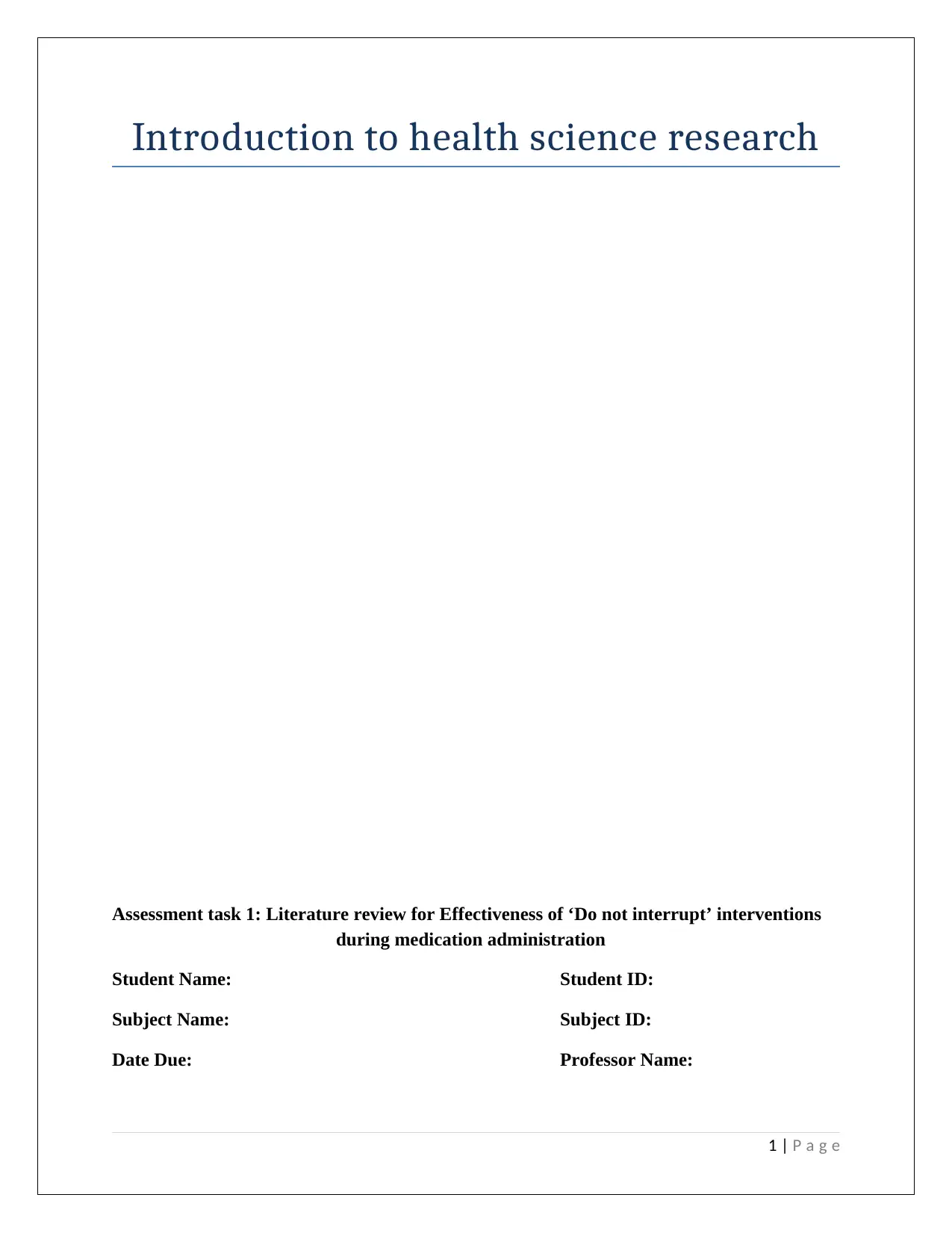
Introduction to health science research
Assessment task 1: Literature review for Effectiveness of ‘Do not interrupt’ interventions
during medication administration
Student Name: Student ID:
Subject Name: Subject ID:
Date Due: Professor Name:
1 | P a g e
Assessment task 1: Literature review for Effectiveness of ‘Do not interrupt’ interventions
during medication administration
Student Name: Student ID:
Subject Name: Subject ID:
Date Due: Professor Name:
1 | P a g e
Secure Best Marks with AI Grader
Need help grading? Try our AI Grader for instant feedback on your assignments.
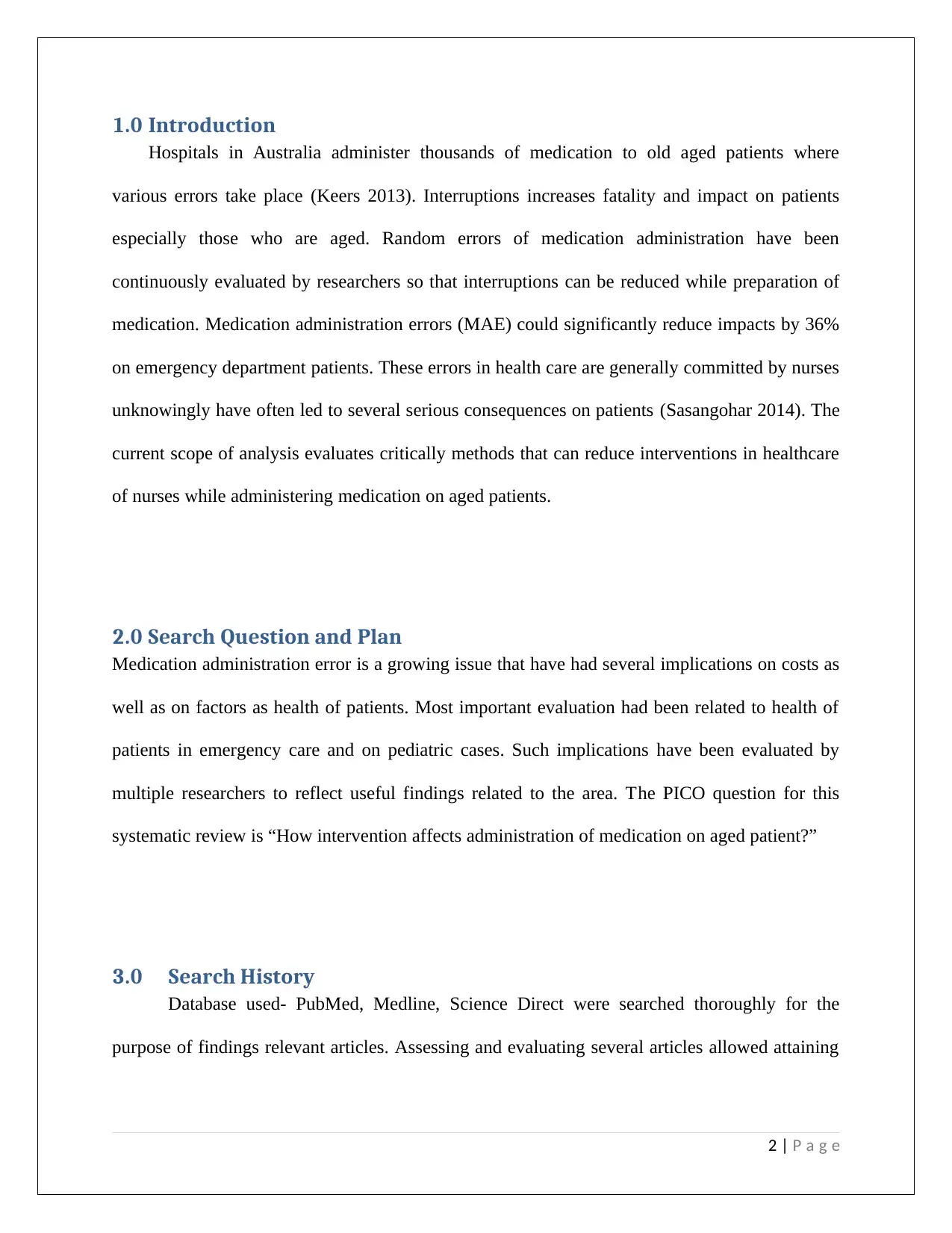
1.0 Introduction
Hospitals in Australia administer thousands of medication to old aged patients where
various errors take place (Keers 2013). Interruptions increases fatality and impact on patients
especially those who are aged. Random errors of medication administration have been
continuously evaluated by researchers so that interruptions can be reduced while preparation of
medication. Medication administration errors (MAE) could significantly reduce impacts by 36%
on emergency department patients. These errors in health care are generally committed by nurses
unknowingly have often led to several serious consequences on patients (Sasangohar 2014). The
current scope of analysis evaluates critically methods that can reduce interventions in healthcare
of nurses while administering medication on aged patients.
2.0 Search Question and Plan
Medication administration error is a growing issue that have had several implications on costs as
well as on factors as health of patients. Most important evaluation had been related to health of
patients in emergency care and on pediatric cases. Such implications have been evaluated by
multiple researchers to reflect useful findings related to the area. The PICO question for this
systematic review is “How intervention affects administration of medication on aged patient?”
3.0 Search History
Database used- PubMed, Medline, Science Direct were searched thoroughly for the
purpose of findings relevant articles. Assessing and evaluating several articles allowed attaining
2 | P a g e
Hospitals in Australia administer thousands of medication to old aged patients where
various errors take place (Keers 2013). Interruptions increases fatality and impact on patients
especially those who are aged. Random errors of medication administration have been
continuously evaluated by researchers so that interruptions can be reduced while preparation of
medication. Medication administration errors (MAE) could significantly reduce impacts by 36%
on emergency department patients. These errors in health care are generally committed by nurses
unknowingly have often led to several serious consequences on patients (Sasangohar 2014). The
current scope of analysis evaluates critically methods that can reduce interventions in healthcare
of nurses while administering medication on aged patients.
2.0 Search Question and Plan
Medication administration error is a growing issue that have had several implications on costs as
well as on factors as health of patients. Most important evaluation had been related to health of
patients in emergency care and on pediatric cases. Such implications have been evaluated by
multiple researchers to reflect useful findings related to the area. The PICO question for this
systematic review is “How intervention affects administration of medication on aged patient?”
3.0 Search History
Database used- PubMed, Medline, Science Direct were searched thoroughly for the
purpose of findings relevant articles. Assessing and evaluating several articles allowed attaining
2 | P a g e
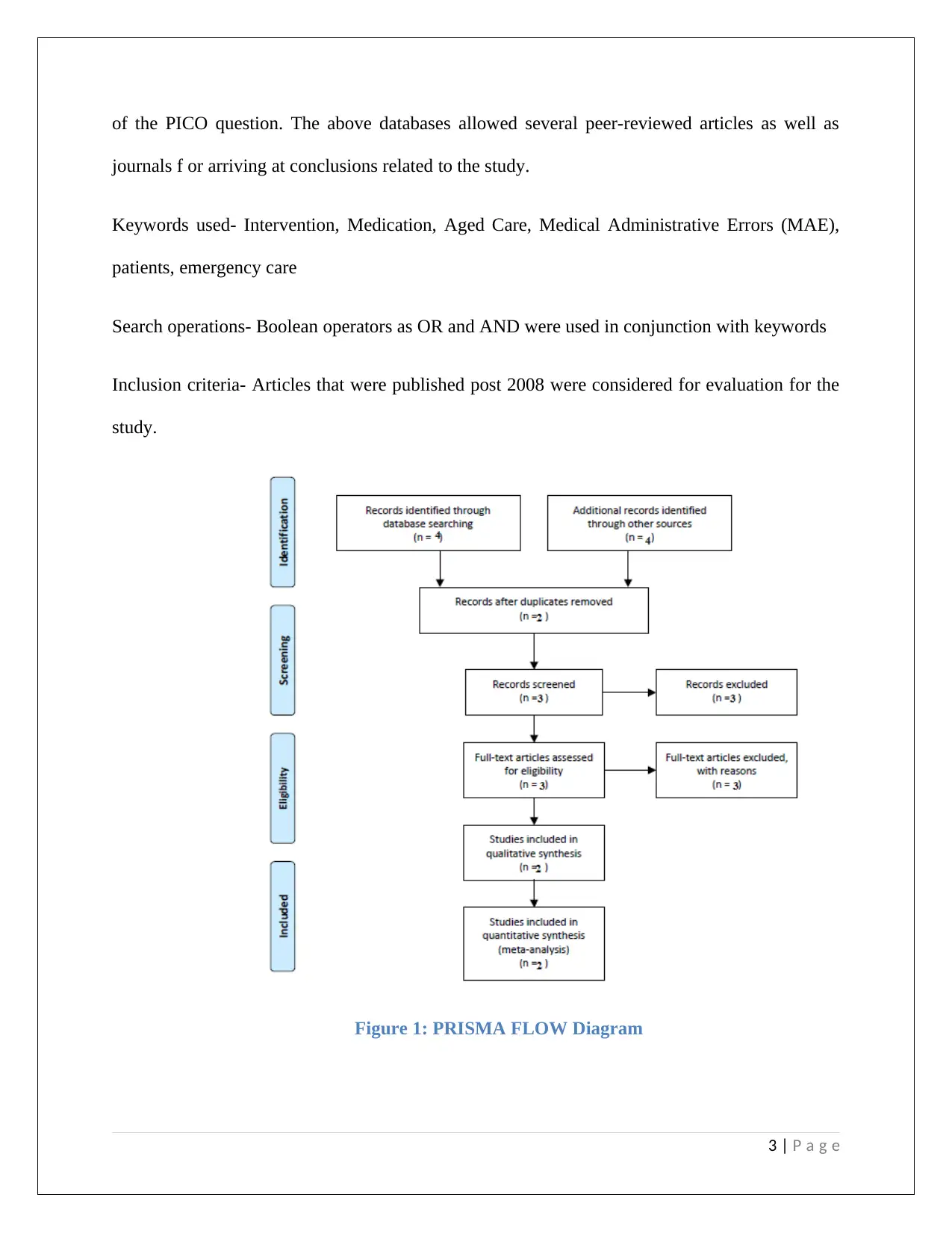
of the PICO question. The above databases allowed several peer-reviewed articles as well as
journals f or arriving at conclusions related to the study.
Keywords used- Intervention, Medication, Aged Care, Medical Administrative Errors (MAE),
patients, emergency care
Search operations- Boolean operators as OR and AND were used in conjunction with keywords
Inclusion criteria- Articles that were published post 2008 were considered for evaluation for the
study.
Figure 1: PRISMA FLOW Diagram
3 | P a g e
journals f or arriving at conclusions related to the study.
Keywords used- Intervention, Medication, Aged Care, Medical Administrative Errors (MAE),
patients, emergency care
Search operations- Boolean operators as OR and AND were used in conjunction with keywords
Inclusion criteria- Articles that were published post 2008 were considered for evaluation for the
study.
Figure 1: PRISMA FLOW Diagram
3 | P a g e
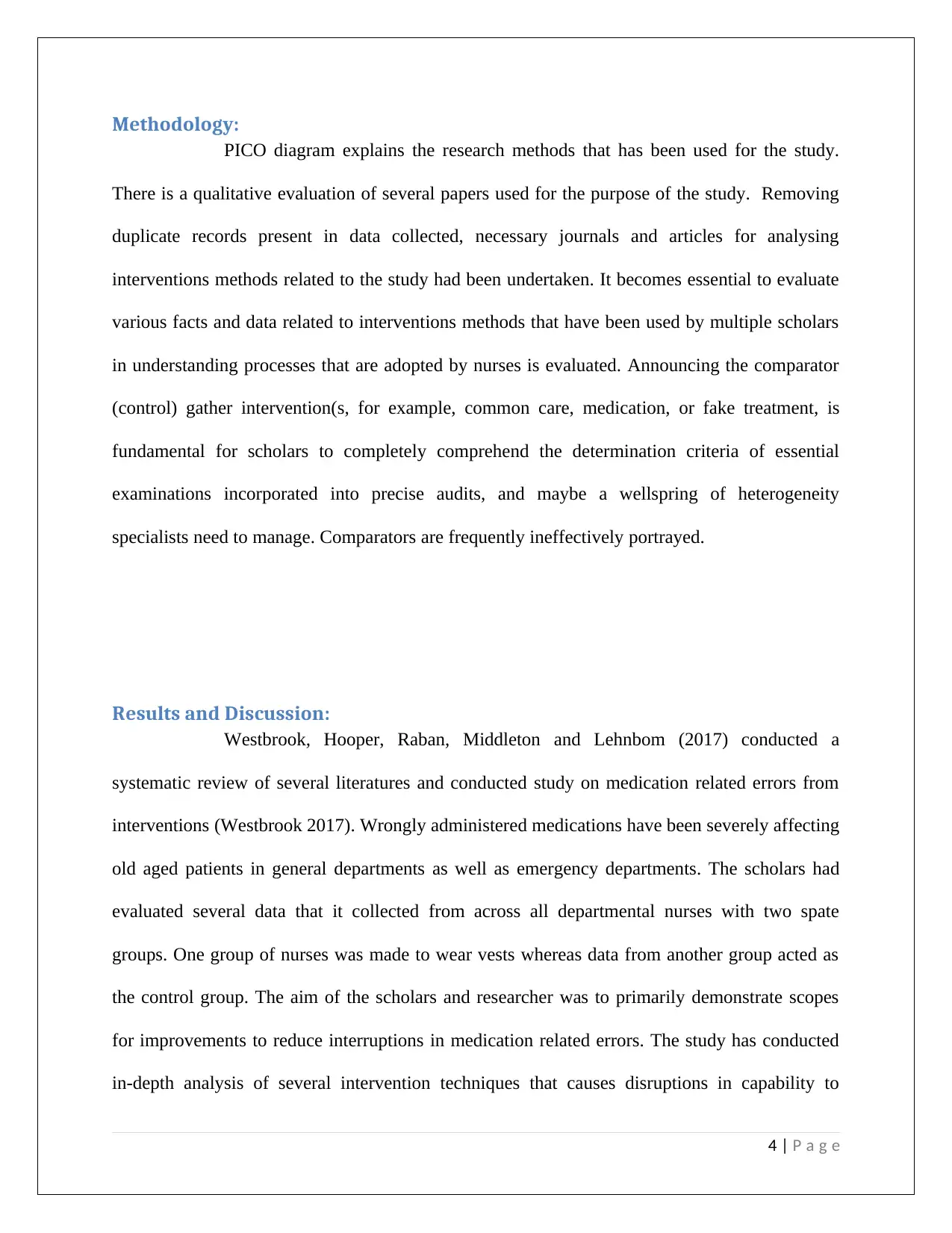
Methodology:
PICO diagram explains the research methods that has been used for the study.
There is a qualitative evaluation of several papers used for the purpose of the study. Removing
duplicate records present in data collected, necessary journals and articles for analysing
interventions methods related to the study had been undertaken. It becomes essential to evaluate
various facts and data related to interventions methods that have been used by multiple scholars
in understanding processes that are adopted by nurses is evaluated. Announcing the comparator
(control) gather intervention(s, for example, common care, medication, or fake treatment, is
fundamental for scholars to completely comprehend the determination criteria of essential
examinations incorporated into precise audits, and maybe a wellspring of heterogeneity
specialists need to manage. Comparators are frequently ineffectively portrayed.
Results and Discussion:
Westbrook, Hooper, Raban, Middleton and Lehnbom (2017) conducted a
systematic review of several literatures and conducted study on medication related errors from
interventions (Westbrook 2017). Wrongly administered medications have been severely affecting
old aged patients in general departments as well as emergency departments. The scholars had
evaluated several data that it collected from across all departmental nurses with two spate
groups. One group of nurses was made to wear vests whereas data from another group acted as
the control group. The aim of the scholars and researcher was to primarily demonstrate scopes
for improvements to reduce interruptions in medication related errors. The study has conducted
in-depth analysis of several intervention techniques that causes disruptions in capability to
4 | P a g e
PICO diagram explains the research methods that has been used for the study.
There is a qualitative evaluation of several papers used for the purpose of the study. Removing
duplicate records present in data collected, necessary journals and articles for analysing
interventions methods related to the study had been undertaken. It becomes essential to evaluate
various facts and data related to interventions methods that have been used by multiple scholars
in understanding processes that are adopted by nurses is evaluated. Announcing the comparator
(control) gather intervention(s, for example, common care, medication, or fake treatment, is
fundamental for scholars to completely comprehend the determination criteria of essential
examinations incorporated into precise audits, and maybe a wellspring of heterogeneity
specialists need to manage. Comparators are frequently ineffectively portrayed.
Results and Discussion:
Westbrook, Hooper, Raban, Middleton and Lehnbom (2017) conducted a
systematic review of several literatures and conducted study on medication related errors from
interventions (Westbrook 2017). Wrongly administered medications have been severely affecting
old aged patients in general departments as well as emergency departments. The scholars had
evaluated several data that it collected from across all departmental nurses with two spate
groups. One group of nurses was made to wear vests whereas data from another group acted as
the control group. The aim of the scholars and researcher was to primarily demonstrate scopes
for improvements to reduce interruptions in medication related errors. The study has conducted
in-depth analysis of several intervention techniques that causes disruptions in capability to
4 | P a g e
Secure Best Marks with AI Grader
Need help grading? Try our AI Grader for instant feedback on your assignments.
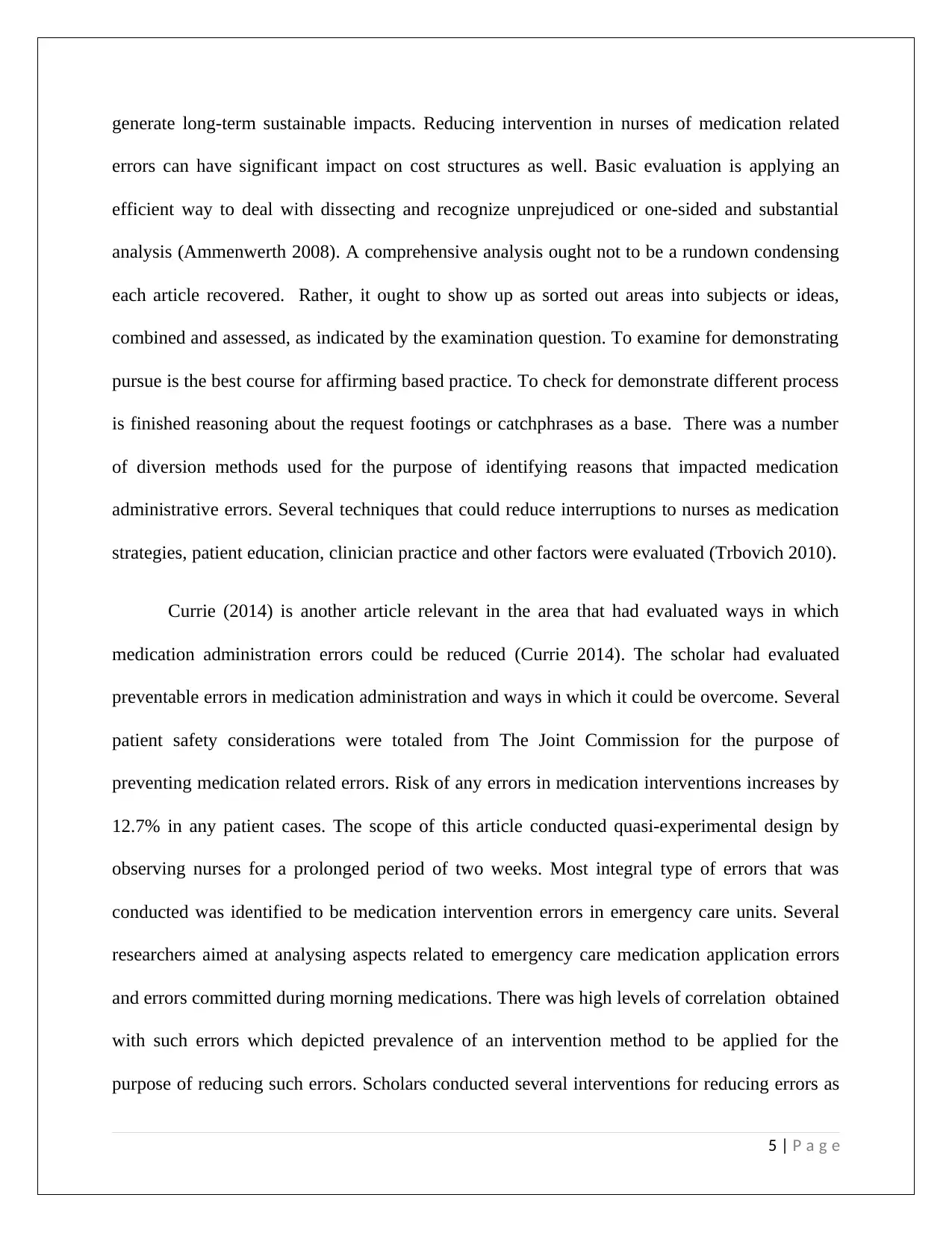
generate long-term sustainable impacts. Reducing intervention in nurses of medication related
errors can have significant impact on cost structures as well. Basic evaluation is applying an
efficient way to deal with dissecting and recognize unprejudiced or one-sided and substantial
analysis (Ammenwerth 2008). A comprehensive analysis ought not to be a rundown condensing
each article recovered. Rather, it ought to show up as sorted out areas into subjects or ideas,
combined and assessed, as indicated by the examination question. To examine for demonstrating
pursue is the best course for affirming based practice. To check for demonstrate different process
is finished reasoning about the request footings or catchphrases as a base. There was a number
of diversion methods used for the purpose of identifying reasons that impacted medication
administrative errors. Several techniques that could reduce interruptions to nurses as medication
strategies, patient education, clinician practice and other factors were evaluated (Trbovich 2010).
Currie (2014) is another article relevant in the area that had evaluated ways in which
medication administration errors could be reduced (Currie 2014). The scholar had evaluated
preventable errors in medication administration and ways in which it could be overcome. Several
patient safety considerations were totaled from The Joint Commission for the purpose of
preventing medication related errors. Risk of any errors in medication interventions increases by
12.7% in any patient cases. The scope of this article conducted quasi-experimental design by
observing nurses for a prolonged period of two weeks. Most integral type of errors that was
conducted was identified to be medication intervention errors in emergency care units. Several
researchers aimed at analysing aspects related to emergency care medication application errors
and errors committed during morning medications. There was high levels of correlation obtained
with such errors which depicted prevalence of an intervention method to be applied for the
purpose of reducing such errors. Scholars conducted several interventions for reducing errors as
5 | P a g e
errors can have significant impact on cost structures as well. Basic evaluation is applying an
efficient way to deal with dissecting and recognize unprejudiced or one-sided and substantial
analysis (Ammenwerth 2008). A comprehensive analysis ought not to be a rundown condensing
each article recovered. Rather, it ought to show up as sorted out areas into subjects or ideas,
combined and assessed, as indicated by the examination question. To examine for demonstrating
pursue is the best course for affirming based practice. To check for demonstrate different process
is finished reasoning about the request footings or catchphrases as a base. There was a number
of diversion methods used for the purpose of identifying reasons that impacted medication
administrative errors. Several techniques that could reduce interruptions to nurses as medication
strategies, patient education, clinician practice and other factors were evaluated (Trbovich 2010).
Currie (2014) is another article relevant in the area that had evaluated ways in which
medication administration errors could be reduced (Currie 2014). The scholar had evaluated
preventable errors in medication administration and ways in which it could be overcome. Several
patient safety considerations were totaled from The Joint Commission for the purpose of
preventing medication related errors. Risk of any errors in medication interventions increases by
12.7% in any patient cases. The scope of this article conducted quasi-experimental design by
observing nurses for a prolonged period of two weeks. Most integral type of errors that was
conducted was identified to be medication intervention errors in emergency care units. Several
researchers aimed at analysing aspects related to emergency care medication application errors
and errors committed during morning medications. There was high levels of correlation obtained
with such errors which depicted prevalence of an intervention method to be applied for the
purpose of reducing such errors. Scholars conducted several interventions for reducing errors as
5 | P a g e
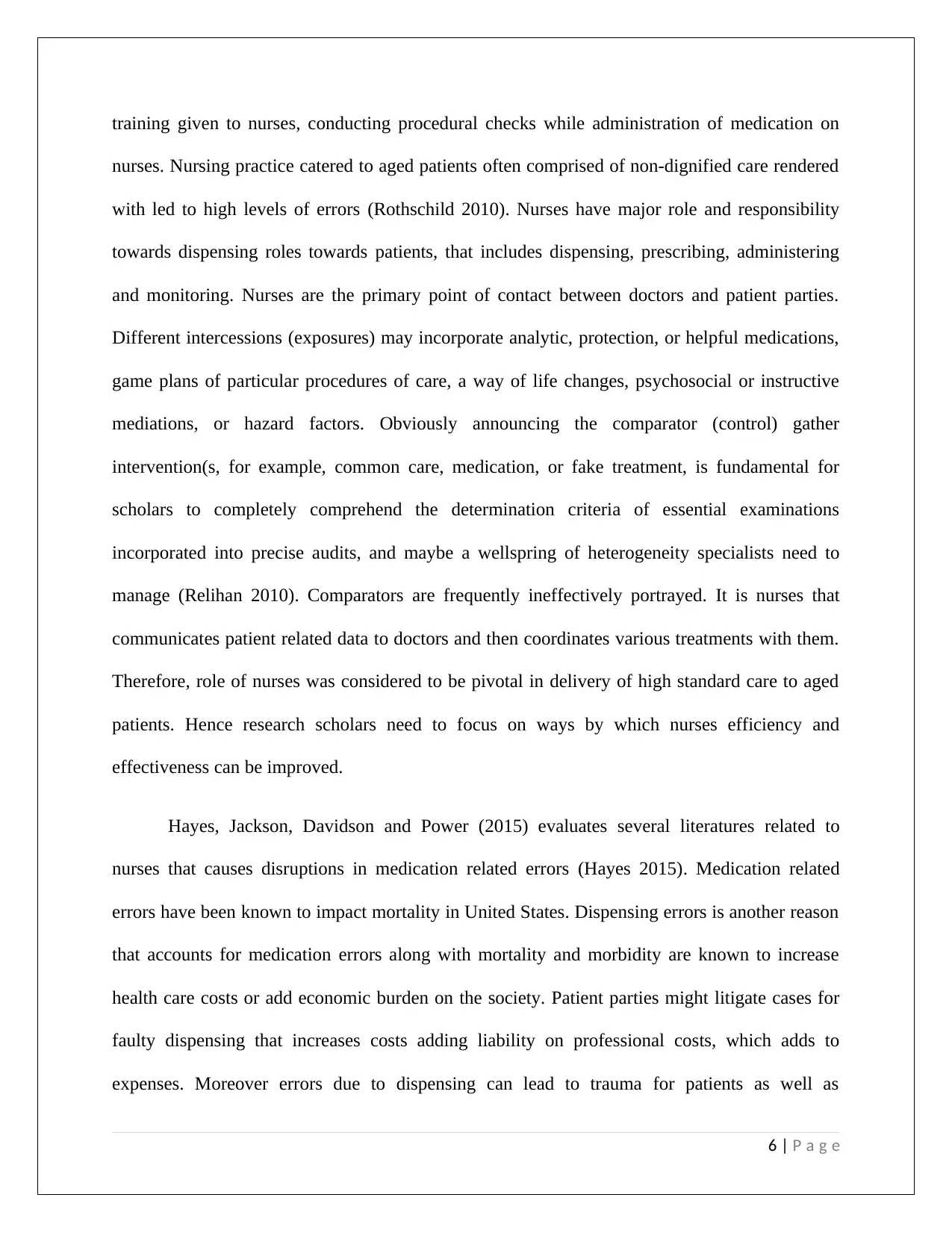
training given to nurses, conducting procedural checks while administration of medication on
nurses. Nursing practice catered to aged patients often comprised of non-dignified care rendered
with led to high levels of errors (Rothschild 2010). Nurses have major role and responsibility
towards dispensing roles towards patients, that includes dispensing, prescribing, administering
and monitoring. Nurses are the primary point of contact between doctors and patient parties.
Different intercessions (exposures) may incorporate analytic, protection, or helpful medications,
game plans of particular procedures of care, a way of life changes, psychosocial or instructive
mediations, or hazard factors. Obviously announcing the comparator (control) gather
intervention(s, for example, common care, medication, or fake treatment, is fundamental for
scholars to completely comprehend the determination criteria of essential examinations
incorporated into precise audits, and maybe a wellspring of heterogeneity specialists need to
manage (Relihan 2010). Comparators are frequently ineffectively portrayed. It is nurses that
communicates patient related data to doctors and then coordinates various treatments with them.
Therefore, role of nurses was considered to be pivotal in delivery of high standard care to aged
patients. Hence research scholars need to focus on ways by which nurses efficiency and
effectiveness can be improved.
Hayes, Jackson, Davidson and Power (2015) evaluates several literatures related to
nurses that causes disruptions in medication related errors (Hayes 2015). Medication related
errors have been known to impact mortality in United States. Dispensing errors is another reason
that accounts for medication errors along with mortality and morbidity are known to increase
health care costs or add economic burden on the society. Patient parties might litigate cases for
faulty dispensing that increases costs adding liability on professional costs, which adds to
expenses. Moreover errors due to dispensing can lead to trauma for patients as well as
6 | P a g e
nurses. Nursing practice catered to aged patients often comprised of non-dignified care rendered
with led to high levels of errors (Rothschild 2010). Nurses have major role and responsibility
towards dispensing roles towards patients, that includes dispensing, prescribing, administering
and monitoring. Nurses are the primary point of contact between doctors and patient parties.
Different intercessions (exposures) may incorporate analytic, protection, or helpful medications,
game plans of particular procedures of care, a way of life changes, psychosocial or instructive
mediations, or hazard factors. Obviously announcing the comparator (control) gather
intervention(s, for example, common care, medication, or fake treatment, is fundamental for
scholars to completely comprehend the determination criteria of essential examinations
incorporated into precise audits, and maybe a wellspring of heterogeneity specialists need to
manage (Relihan 2010). Comparators are frequently ineffectively portrayed. It is nurses that
communicates patient related data to doctors and then coordinates various treatments with them.
Therefore, role of nurses was considered to be pivotal in delivery of high standard care to aged
patients. Hence research scholars need to focus on ways by which nurses efficiency and
effectiveness can be improved.
Hayes, Jackson, Davidson and Power (2015) evaluates several literatures related to
nurses that causes disruptions in medication related errors (Hayes 2015). Medication related
errors have been known to impact mortality in United States. Dispensing errors is another reason
that accounts for medication errors along with mortality and morbidity are known to increase
health care costs or add economic burden on the society. Patient parties might litigate cases for
faulty dispensing that increases costs adding liability on professional costs, which adds to
expenses. Moreover errors due to dispensing can lead to trauma for patients as well as
6 | P a g e
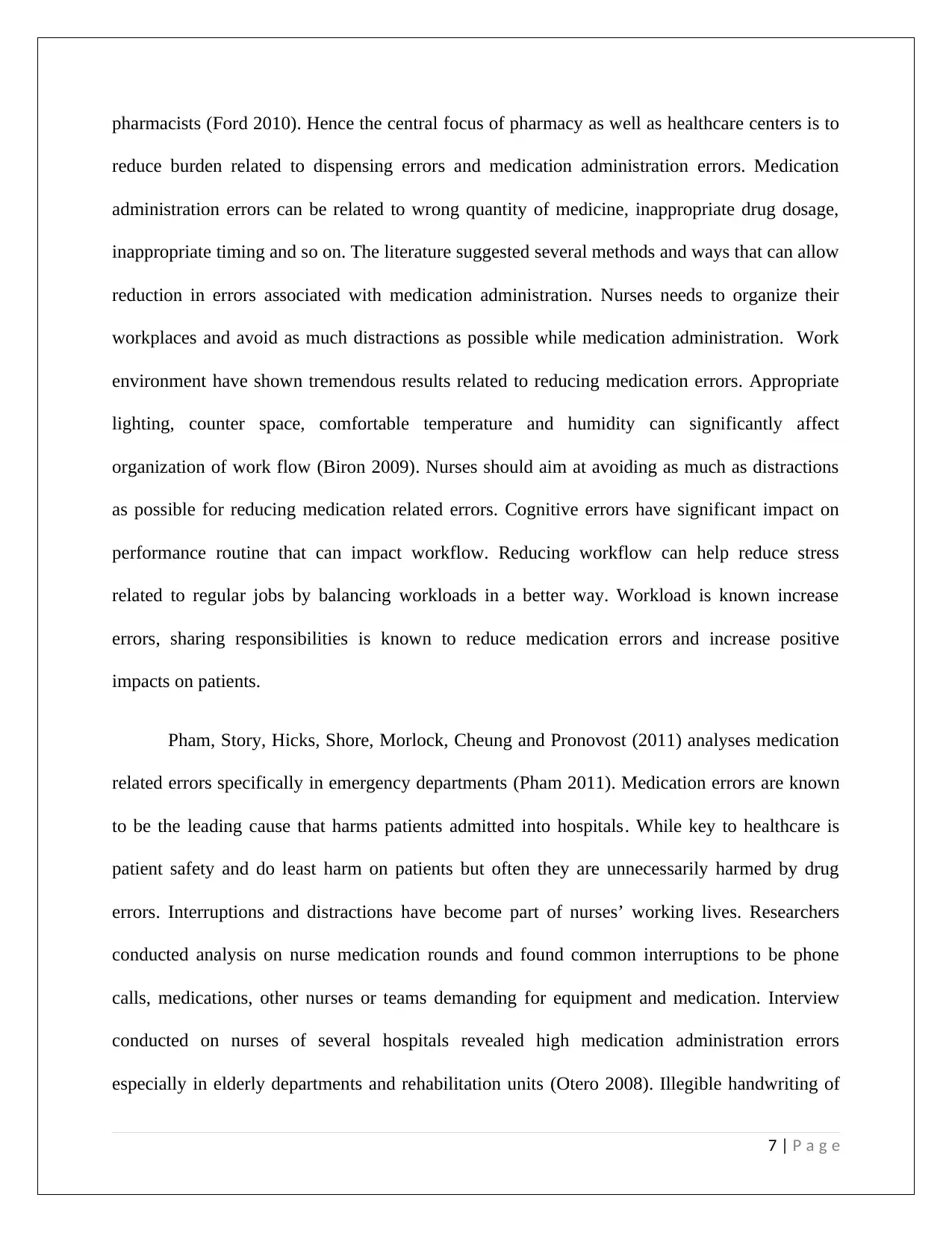
pharmacists (Ford 2010). Hence the central focus of pharmacy as well as healthcare centers is to
reduce burden related to dispensing errors and medication administration errors. Medication
administration errors can be related to wrong quantity of medicine, inappropriate drug dosage,
inappropriate timing and so on. The literature suggested several methods and ways that can allow
reduction in errors associated with medication administration. Nurses needs to organize their
workplaces and avoid as much distractions as possible while medication administration. Work
environment have shown tremendous results related to reducing medication errors. Appropriate
lighting, counter space, comfortable temperature and humidity can significantly affect
organization of work flow (Biron 2009). Nurses should aim at avoiding as much as distractions
as possible for reducing medication related errors. Cognitive errors have significant impact on
performance routine that can impact workflow. Reducing workflow can help reduce stress
related to regular jobs by balancing workloads in a better way. Workload is known increase
errors, sharing responsibilities is known to reduce medication errors and increase positive
impacts on patients.
Pham, Story, Hicks, Shore, Morlock, Cheung and Pronovost (2011) analyses medication
related errors specifically in emergency departments (Pham 2011). Medication errors are known
to be the leading cause that harms patients admitted into hospitals. While key to healthcare is
patient safety and do least harm on patients but often they are unnecessarily harmed by drug
errors. Interruptions and distractions have become part of nurses’ working lives. Researchers
conducted analysis on nurse medication rounds and found common interruptions to be phone
calls, medications, other nurses or teams demanding for equipment and medication. Interview
conducted on nurses of several hospitals revealed high medication administration errors
especially in elderly departments and rehabilitation units (Otero 2008). Illegible handwriting of
7 | P a g e
reduce burden related to dispensing errors and medication administration errors. Medication
administration errors can be related to wrong quantity of medicine, inappropriate drug dosage,
inappropriate timing and so on. The literature suggested several methods and ways that can allow
reduction in errors associated with medication administration. Nurses needs to organize their
workplaces and avoid as much distractions as possible while medication administration. Work
environment have shown tremendous results related to reducing medication errors. Appropriate
lighting, counter space, comfortable temperature and humidity can significantly affect
organization of work flow (Biron 2009). Nurses should aim at avoiding as much as distractions
as possible for reducing medication related errors. Cognitive errors have significant impact on
performance routine that can impact workflow. Reducing workflow can help reduce stress
related to regular jobs by balancing workloads in a better way. Workload is known increase
errors, sharing responsibilities is known to reduce medication errors and increase positive
impacts on patients.
Pham, Story, Hicks, Shore, Morlock, Cheung and Pronovost (2011) analyses medication
related errors specifically in emergency departments (Pham 2011). Medication errors are known
to be the leading cause that harms patients admitted into hospitals. While key to healthcare is
patient safety and do least harm on patients but often they are unnecessarily harmed by drug
errors. Interruptions and distractions have become part of nurses’ working lives. Researchers
conducted analysis on nurse medication rounds and found common interruptions to be phone
calls, medications, other nurses or teams demanding for equipment and medication. Interview
conducted on nurses of several hospitals revealed high medication administration errors
especially in elderly departments and rehabilitation units (Otero 2008). Illegible handwriting of
7 | P a g e
Paraphrase This Document
Need a fresh take? Get an instant paraphrase of this document with our AI Paraphraser
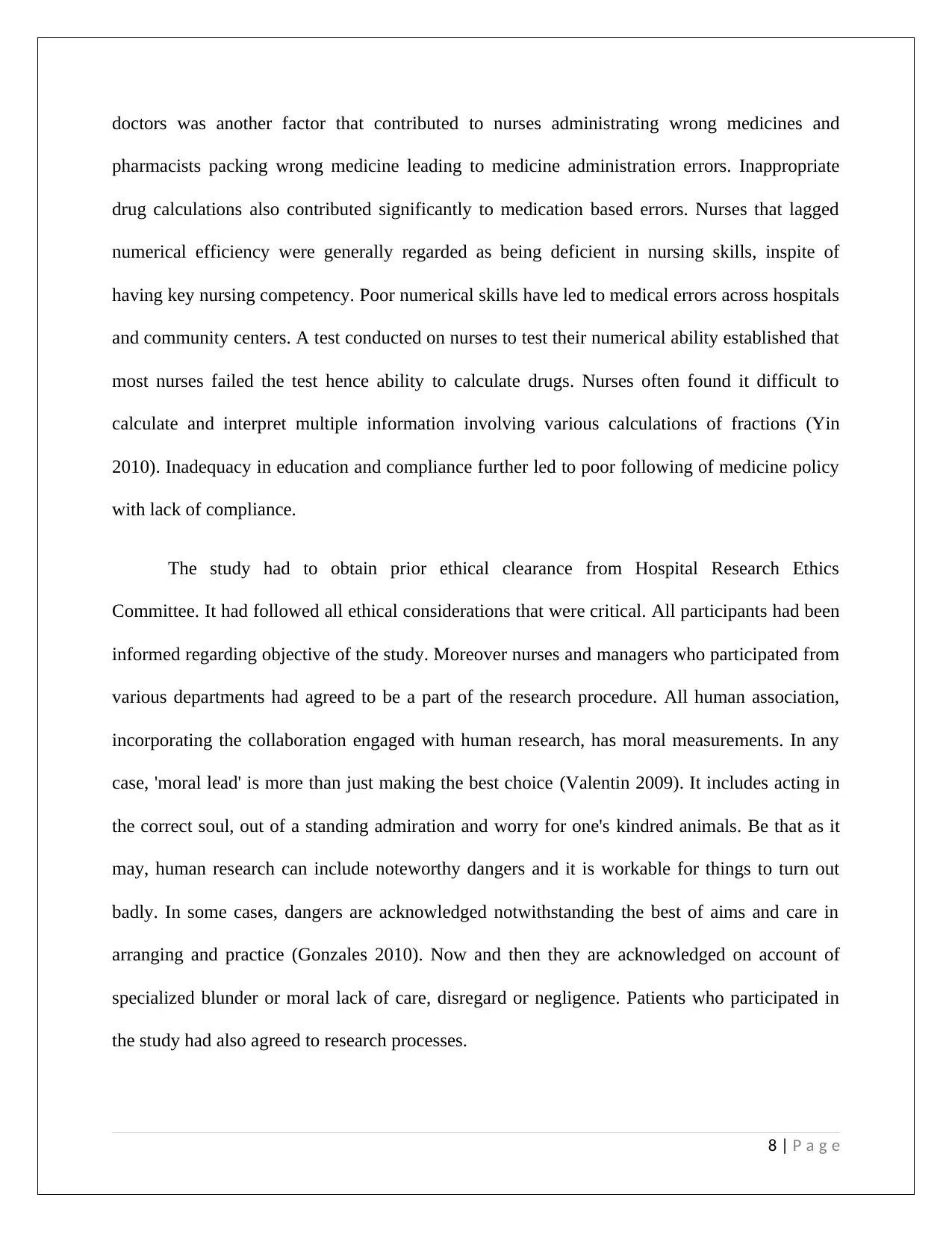
doctors was another factor that contributed to nurses administrating wrong medicines and
pharmacists packing wrong medicine leading to medicine administration errors. Inappropriate
drug calculations also contributed significantly to medication based errors. Nurses that lagged
numerical efficiency were generally regarded as being deficient in nursing skills, inspite of
having key nursing competency. Poor numerical skills have led to medical errors across hospitals
and community centers. A test conducted on nurses to test their numerical ability established that
most nurses failed the test hence ability to calculate drugs. Nurses often found it difficult to
calculate and interpret multiple information involving various calculations of fractions (Yin
2010). Inadequacy in education and compliance further led to poor following of medicine policy
with lack of compliance.
The study had to obtain prior ethical clearance from Hospital Research Ethics
Committee. It had followed all ethical considerations that were critical. All participants had been
informed regarding objective of the study. Moreover nurses and managers who participated from
various departments had agreed to be a part of the research procedure. All human association,
incorporating the collaboration engaged with human research, has moral measurements. In any
case, 'moral lead' is more than just making the best choice (Valentin 2009). It includes acting in
the correct soul, out of a standing admiration and worry for one's kindred animals. Be that as it
may, human research can include noteworthy dangers and it is workable for things to turn out
badly. In some cases, dangers are acknowledged notwithstanding the best of aims and care in
arranging and practice (Gonzales 2010). Now and then they are acknowledged on account of
specialized blunder or moral lack of care, disregard or negligence. Patients who participated in
the study had also agreed to research processes.
8 | P a g e
pharmacists packing wrong medicine leading to medicine administration errors. Inappropriate
drug calculations also contributed significantly to medication based errors. Nurses that lagged
numerical efficiency were generally regarded as being deficient in nursing skills, inspite of
having key nursing competency. Poor numerical skills have led to medical errors across hospitals
and community centers. A test conducted on nurses to test their numerical ability established that
most nurses failed the test hence ability to calculate drugs. Nurses often found it difficult to
calculate and interpret multiple information involving various calculations of fractions (Yin
2010). Inadequacy in education and compliance further led to poor following of medicine policy
with lack of compliance.
The study had to obtain prior ethical clearance from Hospital Research Ethics
Committee. It had followed all ethical considerations that were critical. All participants had been
informed regarding objective of the study. Moreover nurses and managers who participated from
various departments had agreed to be a part of the research procedure. All human association,
incorporating the collaboration engaged with human research, has moral measurements. In any
case, 'moral lead' is more than just making the best choice (Valentin 2009). It includes acting in
the correct soul, out of a standing admiration and worry for one's kindred animals. Be that as it
may, human research can include noteworthy dangers and it is workable for things to turn out
badly. In some cases, dangers are acknowledged notwithstanding the best of aims and care in
arranging and practice (Gonzales 2010). Now and then they are acknowledged on account of
specialized blunder or moral lack of care, disregard or negligence. Patients who participated in
the study had also agreed to research processes.
8 | P a g e
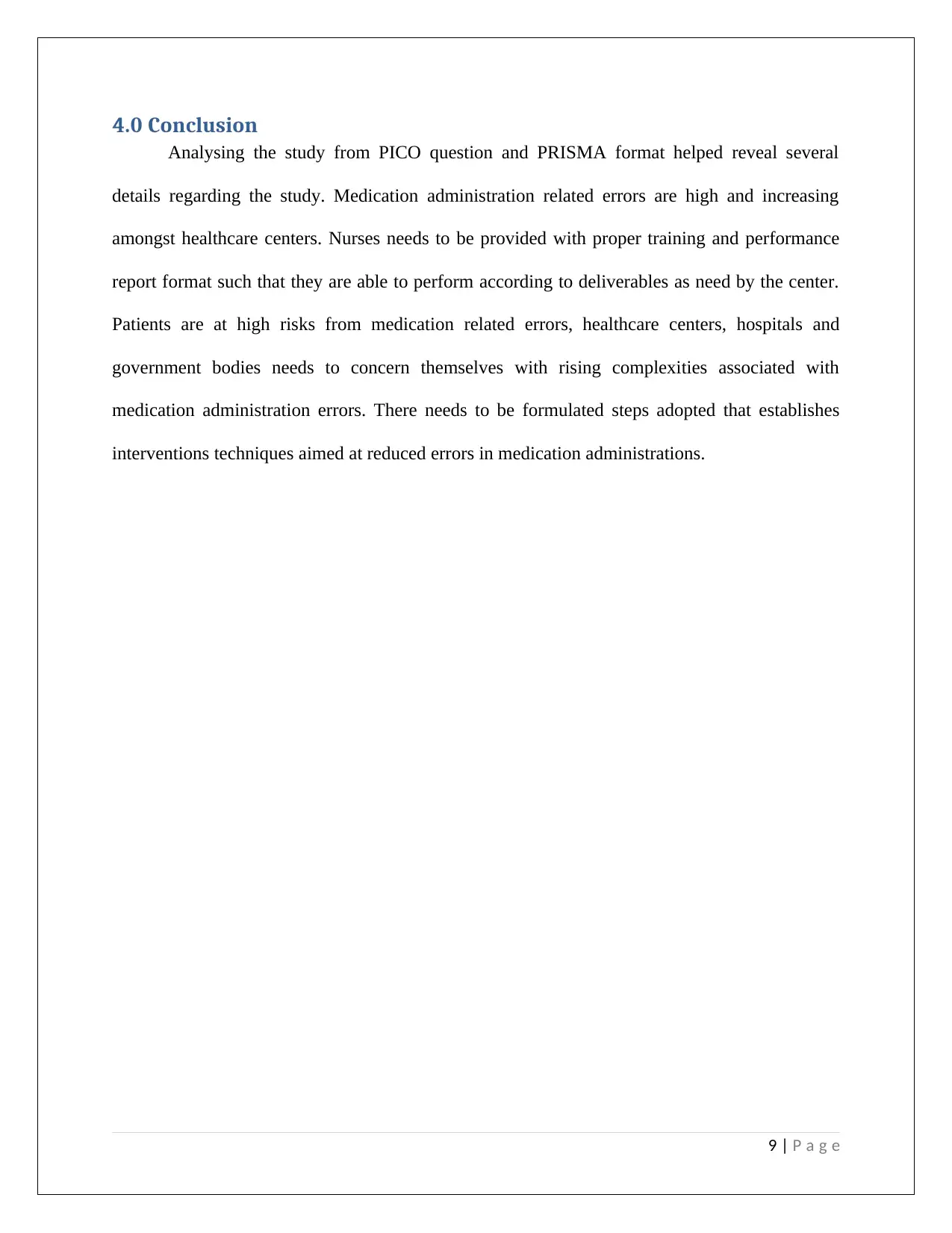
4.0 Conclusion
Analysing the study from PICO question and PRISMA format helped reveal several
details regarding the study. Medication administration related errors are high and increasing
amongst healthcare centers. Nurses needs to be provided with proper training and performance
report format such that they are able to perform according to deliverables as need by the center.
Patients are at high risks from medication related errors, healthcare centers, hospitals and
government bodies needs to concern themselves with rising complexities associated with
medication administration errors. There needs to be formulated steps adopted that establishes
interventions techniques aimed at reduced errors in medication administrations.
9 | P a g e
Analysing the study from PICO question and PRISMA format helped reveal several
details regarding the study. Medication administration related errors are high and increasing
amongst healthcare centers. Nurses needs to be provided with proper training and performance
report format such that they are able to perform according to deliverables as need by the center.
Patients are at high risks from medication related errors, healthcare centers, hospitals and
government bodies needs to concern themselves with rising complexities associated with
medication administration errors. There needs to be formulated steps adopted that establishes
interventions techniques aimed at reduced errors in medication administrations.
9 | P a g e
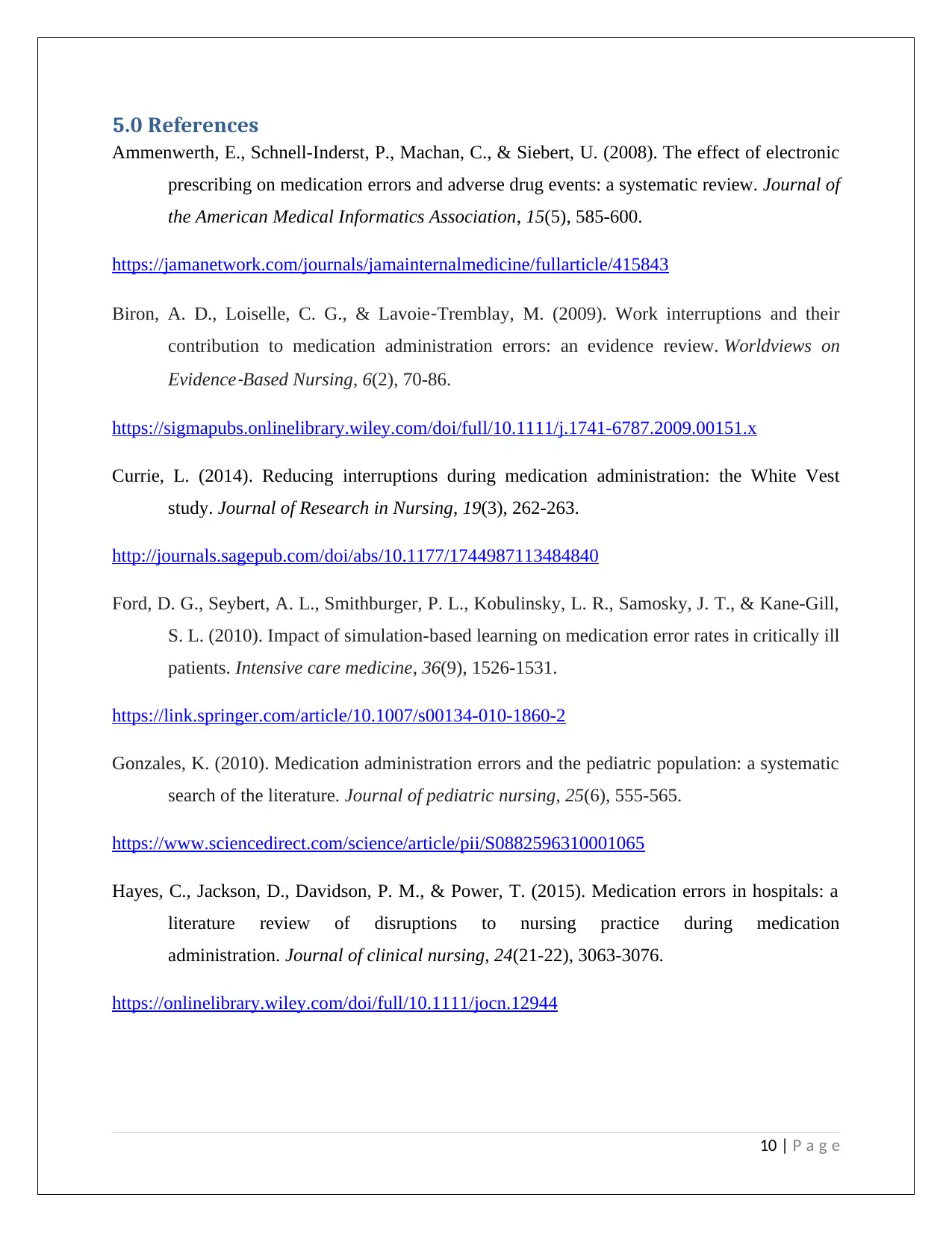
5.0 References
Ammenwerth, E., Schnell-Inderst, P., Machan, C., & Siebert, U. (2008). The effect of electronic
prescribing on medication errors and adverse drug events: a systematic review. Journal of
the American Medical Informatics Association, 15(5), 585-600.
https://jamanetwork.com/journals/jamainternalmedicine/fullarticle/415843
Biron, A. D., Loiselle, C. G., & Lavoie‐Tremblay, M. (2009). Work interruptions and their
contribution to medication administration errors: an evidence review. Worldviews on
Evidence
‐Based Nursing, 6(2), 70-86.
https://sigmapubs.onlinelibrary.wiley.com/doi/full/10.1111/j.1741-6787.2009.00151.x
Currie, L. (2014). Reducing interruptions during medication administration: the White Vest
study. Journal of Research in Nursing, 19(3), 262-263.
http://journals.sagepub.com/doi/abs/10.1177/1744987113484840
Ford, D. G., Seybert, A. L., Smithburger, P. L., Kobulinsky, L. R., Samosky, J. T., & Kane-Gill,
S. L. (2010). Impact of simulation-based learning on medication error rates in critically ill
patients. Intensive care medicine, 36(9), 1526-1531.
https://link.springer.com/article/10.1007/s00134-010-1860-2
Gonzales, K. (2010). Medication administration errors and the pediatric population: a systematic
search of the literature. Journal of pediatric nursing, 25(6), 555-565.
https://www.sciencedirect.com/science/article/pii/S0882596310001065
Hayes, C., Jackson, D., Davidson, P. M., & Power, T. (2015). Medication errors in hospitals: a
literature review of disruptions to nursing practice during medication
administration. Journal of clinical nursing, 24(21-22), 3063-3076.
https://onlinelibrary.wiley.com/doi/full/10.1111/jocn.12944
10 | P a g e
Ammenwerth, E., Schnell-Inderst, P., Machan, C., & Siebert, U. (2008). The effect of electronic
prescribing on medication errors and adverse drug events: a systematic review. Journal of
the American Medical Informatics Association, 15(5), 585-600.
https://jamanetwork.com/journals/jamainternalmedicine/fullarticle/415843
Biron, A. D., Loiselle, C. G., & Lavoie‐Tremblay, M. (2009). Work interruptions and their
contribution to medication administration errors: an evidence review. Worldviews on
Evidence
‐Based Nursing, 6(2), 70-86.
https://sigmapubs.onlinelibrary.wiley.com/doi/full/10.1111/j.1741-6787.2009.00151.x
Currie, L. (2014). Reducing interruptions during medication administration: the White Vest
study. Journal of Research in Nursing, 19(3), 262-263.
http://journals.sagepub.com/doi/abs/10.1177/1744987113484840
Ford, D. G., Seybert, A. L., Smithburger, P. L., Kobulinsky, L. R., Samosky, J. T., & Kane-Gill,
S. L. (2010). Impact of simulation-based learning on medication error rates in critically ill
patients. Intensive care medicine, 36(9), 1526-1531.
https://link.springer.com/article/10.1007/s00134-010-1860-2
Gonzales, K. (2010). Medication administration errors and the pediatric population: a systematic
search of the literature. Journal of pediatric nursing, 25(6), 555-565.
https://www.sciencedirect.com/science/article/pii/S0882596310001065
Hayes, C., Jackson, D., Davidson, P. M., & Power, T. (2015). Medication errors in hospitals: a
literature review of disruptions to nursing practice during medication
administration. Journal of clinical nursing, 24(21-22), 3063-3076.
https://onlinelibrary.wiley.com/doi/full/10.1111/jocn.12944
10 | P a g e
Secure Best Marks with AI Grader
Need help grading? Try our AI Grader for instant feedback on your assignments.
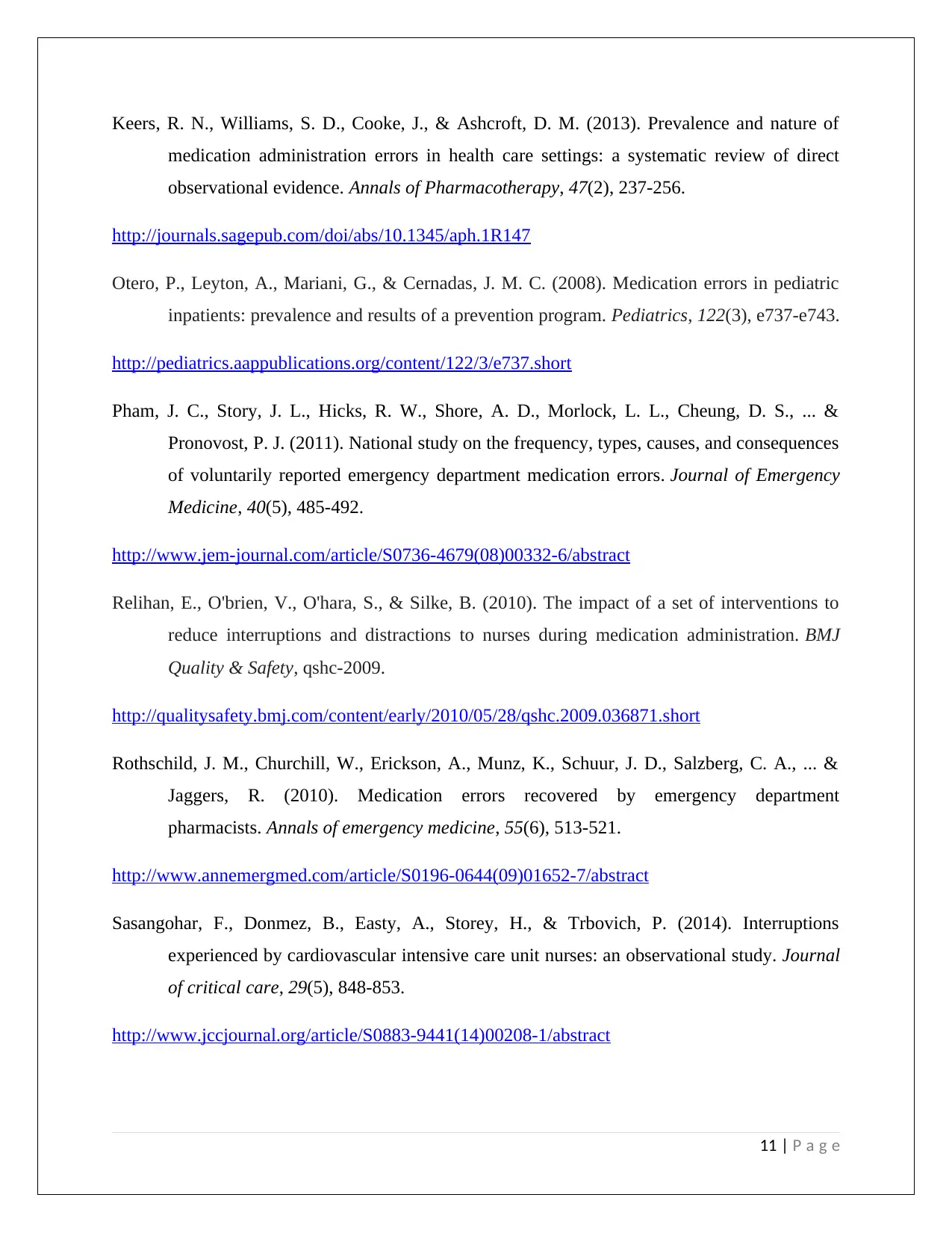
Keers, R. N., Williams, S. D., Cooke, J., & Ashcroft, D. M. (2013). Prevalence and nature of
medication administration errors in health care settings: a systematic review of direct
observational evidence. Annals of Pharmacotherapy, 47(2), 237-256.
http://journals.sagepub.com/doi/abs/10.1345/aph.1R147
Otero, P., Leyton, A., Mariani, G., & Cernadas, J. M. C. (2008). Medication errors in pediatric
inpatients: prevalence and results of a prevention program. Pediatrics, 122(3), e737-e743.
http://pediatrics.aappublications.org/content/122/3/e737.short
Pham, J. C., Story, J. L., Hicks, R. W., Shore, A. D., Morlock, L. L., Cheung, D. S., ... &
Pronovost, P. J. (2011). National study on the frequency, types, causes, and consequences
of voluntarily reported emergency department medication errors. Journal of Emergency
Medicine, 40(5), 485-492.
http://www.jem-journal.com/article/S0736-4679(08)00332-6/abstract
Relihan, E., O'brien, V., O'hara, S., & Silke, B. (2010). The impact of a set of interventions to
reduce interruptions and distractions to nurses during medication administration. BMJ
Quality & Safety, qshc-2009.
http://qualitysafety.bmj.com/content/early/2010/05/28/qshc.2009.036871.short
Rothschild, J. M., Churchill, W., Erickson, A., Munz, K., Schuur, J. D., Salzberg, C. A., ... &
Jaggers, R. (2010). Medication errors recovered by emergency department
pharmacists. Annals of emergency medicine, 55(6), 513-521.
http://www.annemergmed.com/article/S0196-0644(09)01652-7/abstract
Sasangohar, F., Donmez, B., Easty, A., Storey, H., & Trbovich, P. (2014). Interruptions
experienced by cardiovascular intensive care unit nurses: an observational study. Journal
of critical care, 29(5), 848-853.
http://www.jccjournal.org/article/S0883-9441(14)00208-1/abstract
11 | P a g e
medication administration errors in health care settings: a systematic review of direct
observational evidence. Annals of Pharmacotherapy, 47(2), 237-256.
http://journals.sagepub.com/doi/abs/10.1345/aph.1R147
Otero, P., Leyton, A., Mariani, G., & Cernadas, J. M. C. (2008). Medication errors in pediatric
inpatients: prevalence and results of a prevention program. Pediatrics, 122(3), e737-e743.
http://pediatrics.aappublications.org/content/122/3/e737.short
Pham, J. C., Story, J. L., Hicks, R. W., Shore, A. D., Morlock, L. L., Cheung, D. S., ... &
Pronovost, P. J. (2011). National study on the frequency, types, causes, and consequences
of voluntarily reported emergency department medication errors. Journal of Emergency
Medicine, 40(5), 485-492.
http://www.jem-journal.com/article/S0736-4679(08)00332-6/abstract
Relihan, E., O'brien, V., O'hara, S., & Silke, B. (2010). The impact of a set of interventions to
reduce interruptions and distractions to nurses during medication administration. BMJ
Quality & Safety, qshc-2009.
http://qualitysafety.bmj.com/content/early/2010/05/28/qshc.2009.036871.short
Rothschild, J. M., Churchill, W., Erickson, A., Munz, K., Schuur, J. D., Salzberg, C. A., ... &
Jaggers, R. (2010). Medication errors recovered by emergency department
pharmacists. Annals of emergency medicine, 55(6), 513-521.
http://www.annemergmed.com/article/S0196-0644(09)01652-7/abstract
Sasangohar, F., Donmez, B., Easty, A., Storey, H., & Trbovich, P. (2014). Interruptions
experienced by cardiovascular intensive care unit nurses: an observational study. Journal
of critical care, 29(5), 848-853.
http://www.jccjournal.org/article/S0883-9441(14)00208-1/abstract
11 | P a g e
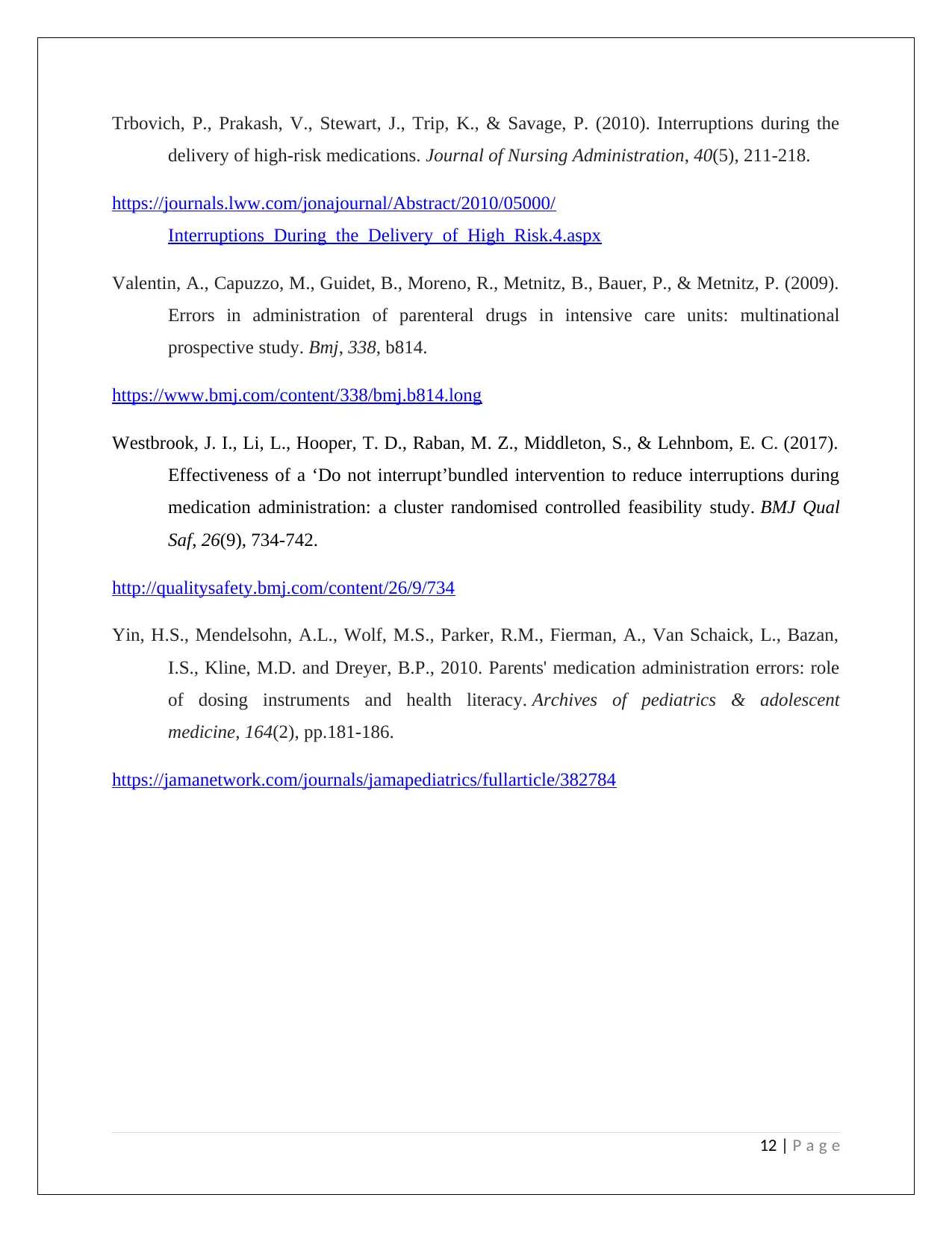
Trbovich, P., Prakash, V., Stewart, J., Trip, K., & Savage, P. (2010). Interruptions during the
delivery of high-risk medications. Journal of Nursing Administration, 40(5), 211-218.
https://journals.lww.com/jonajournal/Abstract/2010/05000/
Interruptions_During_the_Delivery_of_High_Risk.4.aspx
Valentin, A., Capuzzo, M., Guidet, B., Moreno, R., Metnitz, B., Bauer, P., & Metnitz, P. (2009).
Errors in administration of parenteral drugs in intensive care units: multinational
prospective study. Bmj, 338, b814.
https://www.bmj.com/content/338/bmj.b814.long
Westbrook, J. I., Li, L., Hooper, T. D., Raban, M. Z., Middleton, S., & Lehnbom, E. C. (2017).
Effectiveness of a ‘Do not interrupt’bundled intervention to reduce interruptions during
medication administration: a cluster randomised controlled feasibility study. BMJ Qual
Saf, 26(9), 734-742.
http://qualitysafety.bmj.com/content/26/9/734
Yin, H.S., Mendelsohn, A.L., Wolf, M.S., Parker, R.M., Fierman, A., Van Schaick, L., Bazan,
I.S., Kline, M.D. and Dreyer, B.P., 2010. Parents' medication administration errors: role
of dosing instruments and health literacy. Archives of pediatrics & adolescent
medicine, 164(2), pp.181-186.
https://jamanetwork.com/journals/jamapediatrics/fullarticle/382784
12 | P a g e
delivery of high-risk medications. Journal of Nursing Administration, 40(5), 211-218.
https://journals.lww.com/jonajournal/Abstract/2010/05000/
Interruptions_During_the_Delivery_of_High_Risk.4.aspx
Valentin, A., Capuzzo, M., Guidet, B., Moreno, R., Metnitz, B., Bauer, P., & Metnitz, P. (2009).
Errors in administration of parenteral drugs in intensive care units: multinational
prospective study. Bmj, 338, b814.
https://www.bmj.com/content/338/bmj.b814.long
Westbrook, J. I., Li, L., Hooper, T. D., Raban, M. Z., Middleton, S., & Lehnbom, E. C. (2017).
Effectiveness of a ‘Do not interrupt’bundled intervention to reduce interruptions during
medication administration: a cluster randomised controlled feasibility study. BMJ Qual
Saf, 26(9), 734-742.
http://qualitysafety.bmj.com/content/26/9/734
Yin, H.S., Mendelsohn, A.L., Wolf, M.S., Parker, R.M., Fierman, A., Van Schaick, L., Bazan,
I.S., Kline, M.D. and Dreyer, B.P., 2010. Parents' medication administration errors: role
of dosing instruments and health literacy. Archives of pediatrics & adolescent
medicine, 164(2), pp.181-186.
https://jamanetwork.com/journals/jamapediatrics/fullarticle/382784
12 | P a g e
1 out of 12
Related Documents
Your All-in-One AI-Powered Toolkit for Academic Success.
+13062052269
info@desklib.com
Available 24*7 on WhatsApp / Email
![[object Object]](/_next/static/media/star-bottom.7253800d.svg)
Unlock your academic potential
© 2024 | Zucol Services PVT LTD | All rights reserved.





